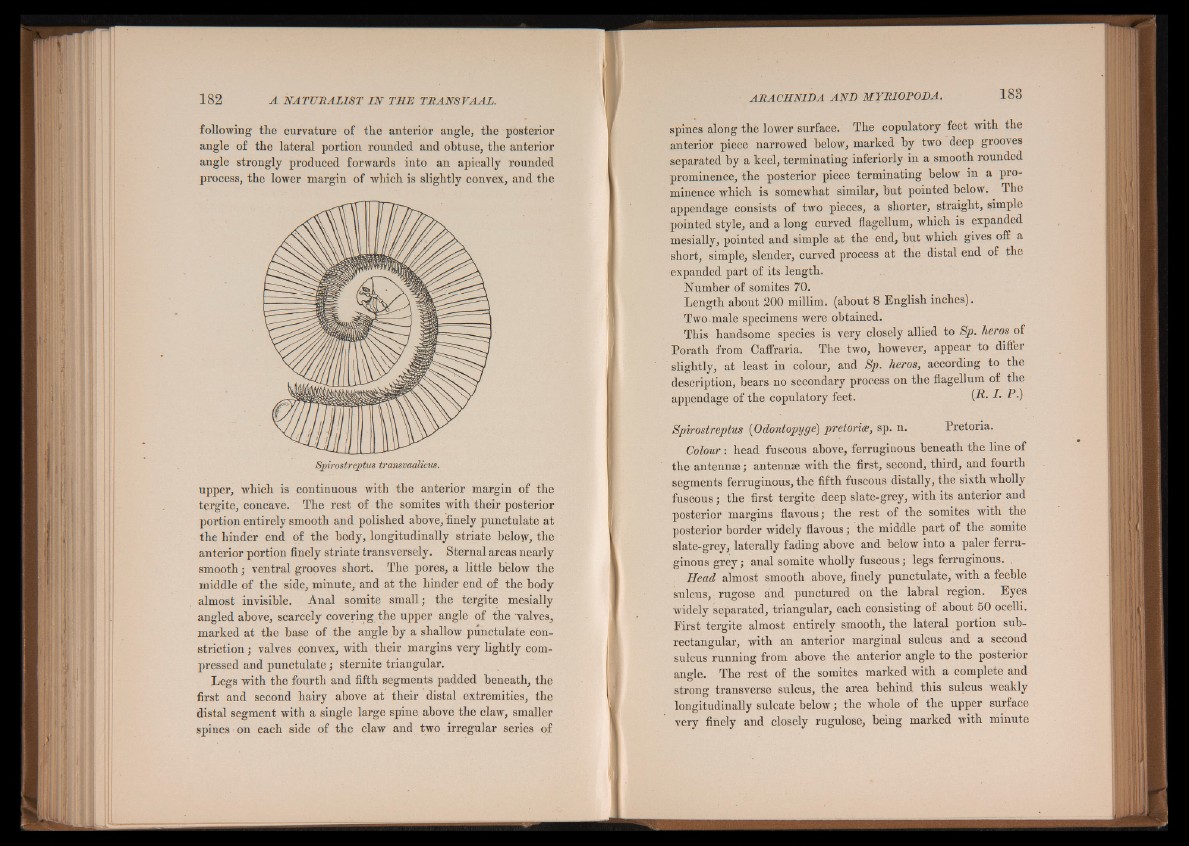
following the curvature of the anterior angle, the posterior
angle of the lateral portion rounded and obtuse, the anterior
angle strongly produced forwards into an apically rounded
process, the lower margin of which is slightly convex, and the
Spirostreptus transvaalicus.
upper, which is continuous with the anterior margin of the
tergite, concave. The rest of the somites with their posterior
portion entirely smooth and polished above, finely punctulate at
the hinder end of the body, longitudinally striate below, the
anterior portion finely striate transversely. Sternal areas nearly
smooth; ventral grooves short. The pores, a little below the
middle of the side, minute, and at the hinder end of the body
almost invisible. Anal somite small; the tergite mesially
angled above, scarcely covering.the upper angle of the valves,
marked at the base of the angle by a shallow punctulate constriction
; valves convex, with their margins very lightly compressed
and punctulate; sternite triangular.
Legs with the fourth and fifth segments padded beneath, the
first and second hairy above at their distal extremities, the
distal segment with a single large spine above the claw, smaller
spines on each side of the claw and two irregular series of
spines along the lower surface. The copulatory feet with the
anterior piece narrowed below, marked by two deep grooves
separated by a keel, terminating inferiorly in a smooth rounded
prominence, the posterior piece terminating below in a prominence
which is somewhat similar, but pointed below. The
appendage consists of two pieces, a shorter, straight, simple
pointed style, and a long curved flagellum, which is expanded
mesially, pointed and simple at the end, but which gives off a
short, simple, slender, curved process at the distal end of the
expanded part of its length.
Number of somites 70.
Length about 200 millim. (about 8 English inches).
Two male specimens were obtained.
This handsome species is very closely allied to Sp. lieros of
Porath from Caffraria. The two, however, appear to differ
slightly, at least in colour, and Sp. heros, according to the
description, bears no secondary process on the flagellum of the
appendage of the copulatory feet. (-R- ?•)
Spirostreptus (Odontopyge) pretorioe, sp. n. Pretoria.
Colour: head fuscous above, ferruginous beneath the line of
the antennae; antennae with the first, second, third, and fourth
segments ferruginous, the fifth fuscous distally, the sixth wholly
fuscous ; the first tergite deep slate-grey, with its anterior and
posterior margins flavous; the rest of the somites with the
posterior border widely flavous; the middle part of the somite
slate-grey, laterally fading above and below into a paler ferruginous
grey; anal somite wholly fuscous; legs ferruginous. .
Head almost smooth above, finely punctulate, with a feeble
sulcus, rugose and punctured on the labral region. Eyes
widely separated, triangular, each consisting of about 50 ocelli.
First tergite almost entirely smooth, the lateral portion sub-
rectangular, with an anterior marginal sulcus and a second
sulcus running from above the anterior angle to the posterior
angle. The rest of the somites marked with a complete and
strong transverse sulcus, the area behind this sulcus weakly
longitudinally sulcate below; the whole of the upper surface
very finely and closely rugulose, being marked with minute